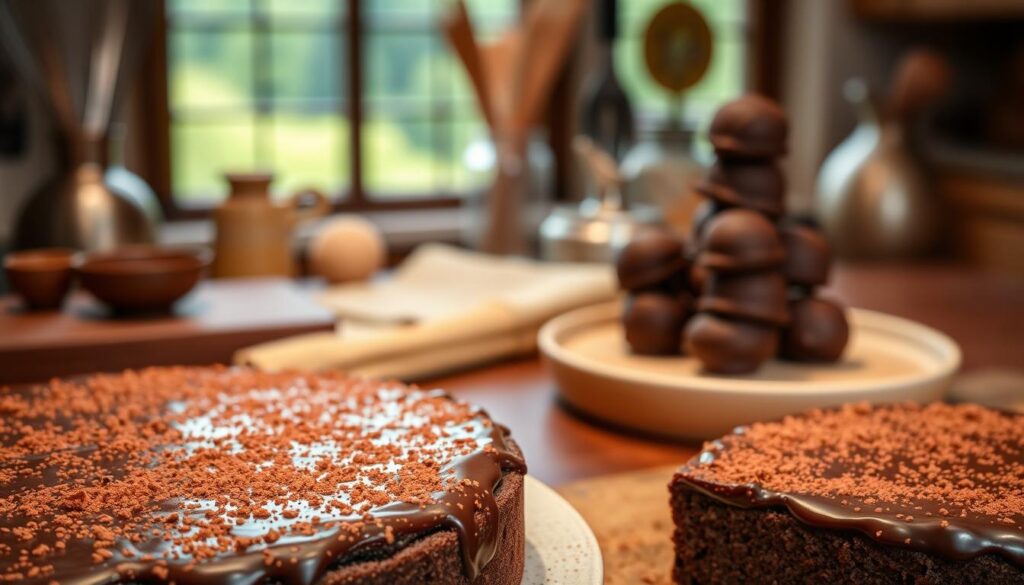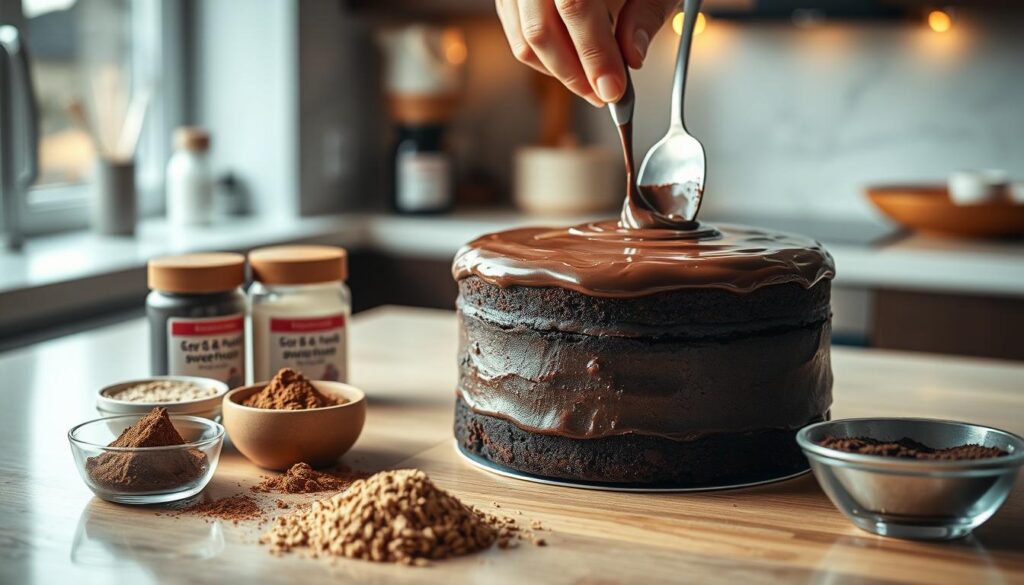Imagine enjoying a rich chocolate treat that satisfies your sweet tooth without ruining your keto diet. This keto chocolate recipe turns the classic indulgence into a guilt-free pleasure. It shows that healthy eating doesn’t mean giving up flavor.
Chocolate lovers on a low-carb diet often find it hard to find sugar-free sweets that really satisfy. Our keto chocolate recipe changes that, offering a rich, creamy taste with very few carbs.
If you’re on a ketogenic diet or just looking for healthier dessert options, this recipe is your new kitchen secret. Get ready to enjoy a chocolate experience that’s both nutritious and delicious.
Table of Contents
Understanding the Magic of Keto Chocolate
Exploring healthy chocolate treats opens a world of tasty ketogenic snacks. These treats satisfy your sweet cravings while staying true to your diet. Keto chocolate is a game-changer for enjoying rich flavors without diet limits.
Making gluten-free chocolate recipes involves understanding keto-friendly ingredients. The secret is choosing the right ingredients. This turns regular chocolate into a low-carb treat.
What Makes Chocolate Keto-Friendly
Keto chocolate is special because of its nutritional benefits. It has:
- Very low net carbs
- High amounts of healthy fats
- Little to no sugar or sugar substitutes
- Good protein content
Benefits of Low-Carb Chocolate
Your favorite chocolate can now fit into a keto diet. The advantages go beyond just taste:
- It keeps your body in ketosis
- It gives you lasting energy
- It helps keep blood sugar stable
- It’s packed with nutrients
Key Nutritional Aspects
Let’s look at the nutritional benefits of keto chocolate. A single serving offers:
- Calories: About 203 cal
- Net Carbohydrates: Only 3g per serving
- Fat: 17g (mostly from good sources)
- Protein: 2g to help keep muscles strong
Choosing ingredients like unsweetened chocolate, avocado oil, and natural sweeteners makes keto chocolate both tasty and healthy.
Essential Ingredients for Perfect Keto Chocolate
Making diabetic-friendly treats means picking the right ingredients. These ingredients turn regular chocolate into treats you can feel good about. Your keto chocolate adventure begins with knowing the key parts that make low-carb chocolate tasty and healthy.
- Unsweetened Cocoa Powder: The base of chocolate’s deep flavor
- Coconut Oil: Adds a smooth texture and healthy fats
- Low-carb sweeteners like stevia or erythritol
- High percentage dark chocolate (70% or higher)
Choosing the right ingredients is key to making a tasty keto treat. The right mix lets you enjoy chocolate without giving up on your diet.
| Ingredient | Quantity | Carb Content |
|---|---|---|
| Unsweetened Dark Chocolate | 9 oz | 2.3g net carbs |
| Almond Butter | 1 cup | 3.5g net carbs |
| Keto Maple Syrup | ½ cup | 1.4g net carbs |
When picking ingredients, go for high-quality, low-carb ones. ChocZero and Lily’s chocolate chips are great keto options. They’re sweetened with monk fruit and erythritol.
Pro tip: Always check nutrition labels to ensure your ingredients align with your keto nutritional goals.
By picking the right ingredients, you’ll make chocolate that’s sweet and keeps you on track with your diet.
The Science Behind Sugar-Free Chocolate Making
Making delicious fat-bomb chocolates needs a good grasp of food science and exact techniques. You’ll learn about complex chemical reactions that turn simple ingredients into creamy high-fat desserts.
The secret to sugar-free chocolate is in the right ingredients and careful preparation. Knowing how these ingredients work together can make your keto chocolate truly special.
Role of Different Sweeteners
Choosing the right sweetener is key for tasty sugar-free chocolates. Keto-friendly options include:
- Erythritol (zero calories, no blood sugar impact)
- Stevia (natural, zero-calorie sweetener)
- Allulose (low-calorie alternative)
- Monk fruit sweetener
Temperature Control Basics
Controlling temperature is vital in chocolate making. Temperatures between 86°F and 90°F create the perfect chocolate consistency. This range stops sugar crystals from forming, giving you smooth, glossy chocolates.
Texture Development
Getting the right texture in high-fat desserts is all about molecular interactions. Coconut oil is key for a melt-in-your-mouth feel. Use two tablespoons of coconut oil per cup of chocolate for the best smoothness.
Chocolate making is part science, part art – mastering both leads to exceptional keto treats.
Keto Chocolate Recipe: Step-by-Step Guide
Making a tasty keto chocolate recipe at home is simple. This dessert is low in carbs but high in flavor. It’s perfect for those who love chocolate and follow a keto diet.
Here are the key ingredients you’ll need for your homemade keto chocolate:
- ½ cup coconut oil
- ¼ cup Dutch-processed cocoa powder
- ¼ cup powdered sweetener (monk fruit or erythritol)
- 1 tsp vanilla extract (optional)
- Pinch of salt
The step-by-step process for making your keto chocolate is straightforward:
- Melt coconut oil in a double boiler or microwave
- Whisk in cocoa powder until smooth
- Add sweetener and mix thoroughly
- Stir in vanilla and salt
- Pour into silicone molds or a lined baking sheet
- Freeze for 20 minutes until set
Your homemade keto chocolate is packed with good stuff. Each piece has only 3g of carbs, 142 calories, and 15g of fat. You’ll get about 4.5 ounces of chocolate, great for when you need a chocolate fix without breaking your diet.
Pro tip: Store your keto chocolate in an airtight container in the refrigerator for up to one week. This ensures maximum freshness and prevents melting.
Mastering the Art of Chocolate Tempering
Tempering is a key technique that turns simple sugar-free sweets into top-notch healthy chocolate treats. It affects the chocolate’s look, feel, and taste. This is why it’s so important for those who love keto chocolate.
Getting good at chocolate tempering takes skill and patience. It involves heating and cooling chocolate just right. This creates a glossy look and a nice snap when you break it.
Navigating Common Tempering Challenges
Tempering chocolate can be hard, with several common problems:
- Overheating chocolate, which ruins its crystal structure
- Adding moisture during tempering
- Not keeping the temperature steady
- Choosing the wrong type of chocolate
Professional Tempering Tips
Here are some expert tips to make your healthy chocolate treats even better:
- Use a digital thermometer for accurate temperature checks
- Work with high-quality dark chocolate (60-70% cocoa solids)
- Keep your working temperature between 88-90°F
Storage and Preservation Guidelines
Storing your tempered chocolate right is key to keeping it fresh:
| Storage Method | Temperature | Duration |
|---|---|---|
| Room Temperature | 60-70°F | Up to 2 weeks |
| Refrigeration | 40-45°F | Up to 2 months |
| Freezing | Below 32°F | 3-4 months |
Pro tip: Let tempered chocolate come back to room temperature slowly. This prevents moisture and keeps it looking perfect.
Variations and Flavor Enhancements

Creating tasty ketogenic diet snacks doesn’t mean you have to give up flavor. Your gluten-free chocolate recipes can get a boost with exciting mix-ins and creative additions. These keep your treats both delicious and low in carbs.
Nuts and seeds add amazing texture and nutrients to keto chocolate. Here are some tasty options:
- Toasted almonds for crunch
- Crushed pecans for richness
- Pumpkin seeds for added minerals
- Unsweetened coconut flakes for tropical flair
Flavor extracts can take your keto chocolate to the next level. A few drops of pure vanilla, mint, or orange extract can add complex flavors without carbs.
“Creativity in the kitchen transforms healthy eating from a challenge to an adventure.” – Keto Cooking Experts
Natural nut butters like unsweetened peanut butter or almond butter can add creamy richness. They blend well, making your snacks indulgent yet low in carbs.
Try different chocolate forms to keep your gluten-free chocolate recipes fresh:
- Chocolate bark with mixed nuts
- Truffles with herb-infused centers
- Chocolate cups filled with nut butter
- Chocolate-dipped strawberries
The secret to amazing keto chocolate is finding the right balance of flavors and keeping carbs low. Your taste buds and health goals can both be happy!
Troubleshooting Common Issues
Making keto chocolate can sometimes be tricky. Knowing common problems helps you make diabetic-friendly treats with ease and skill.
Texture Challenges
Many people struggle with grainy or uneven chocolate texture. To get smooth chocolate, remember:
- Use finely ground sweeteners
- Control the melting temperature well
- Stir constantly while making it
- Choose high-quality cocoa butter
Balancing Sweetness
Finding the right sweetness in diabetic treats is key. Try using natural sweeteners like stevia and monk fruit. They let you enjoy sweet treats without guilt.
Try making small batches to find your ideal sweetness.
Setting and Hardening Issues
Keto chocolate might not set right because of fat types. For it to harden well:
- Use cocoa butter as your main fat
- Keep the tempering temperature exact
- Let it cool for a good amount of time
- Store it in a cool, dry place
Pro tip: Refrigeration can help stabilize your keto chocolate and improve its setting process.
Creative Ways to Use Your Keto Chocolate

Your homemade keto chocolate opens up a world of delicious possibilities. It’s not just for snacking. These versatile fat-bomb chocolates can make your low-carb desserts amazing with little effort and lots of flavor.
Transform your high-fat desserts with these exciting culinary applications:
- Create decadent keto chocolate mousse with just three ingredients:
- Heavy cream
- Sugar-free chocolate
- Vanilla extract
- Craft elegant chocolate truffles by coating nuts or berries
- Use as a rich coating for fat-bomb chocolates
- Develop complex dessert recipes like keto brownies
Let’s dive into some nutritional highlights of a classic keto chocolate mousse:
- Net carbs: 2 grams per serving
- Calories: 206 kcal
- Fat: 22 grams
- Protein: 1 gram
For optimal results, remember these pro tips when experimenting with your keto chocolate:
- Mix ingredients gently to maintain texture
- Use room temperature heavy cream
- Store mousses and fat-bomb chocolates in the refrigerator
- Freeze portions for extended enjoyment
Your homemade keto chocolate is not just a treat. It’s a versatile ingredient that can elevate your low-carb culinary adventures.
Health Benefits and Dietary Considerations
Keto chocolate is a tasty treat that’s good for you. Dark chocolate is especially great for those on a ketogenic diet. It combines delicious taste with health benefits.
Dark chocolate is full of nutrients. It has a lot of fiber, protein, and minerals like potassium and magnesium. These nutrients are good for your health.
- Contains 10.9g of dietary fiber per 100g serving
- Delivers 7.79g of protein
- Rich in essential minerals like potassium, magnesium, and iron
Dark chocolate is also good for your heart. It has antioxidants that help keep your heart healthy. But, remember to eat it in small amounts. A 100g serving has 598 kcal and 35g of carbs.
If you have diabetes or follow a ketogenic diet, choose dark chocolate with 85% cocoa. This type has less sugar and fits better with your diet.
Moderation is key: Choose chocolate wisely to maintain your nutritional goals.
Adding chocolate to your diet can be part of a healthy plan. By picking high-quality chocolate and eating it in moderation, you can enjoy it while staying healthy.
Tips for Perfect Results Every Time

Making the perfect keto chocolate recipe needs focus and detail. Your low-carb desserts will impress when you learn a few key tips. These tips will help you get delicious results every time.
Temperature is key in making keto chocolate. Always use room temperature ingredients for smooth textures. Precise measurements are your secret weapon for success.
- Measure ingredients exactly using digital kitchen scales
- Use high-quality cocoa powder for rich chocolate flavor
- Select sugar-free sweeteners specifically designed for low-carb baking
- Invest in an accurate cooking thermometer
When making your keto chocolate, focus on ingredient quality. Choose sugar-free chocolate chips for a smooth melt. Almond flour or coconut flour are great low-carb bases.
“Perfection in keto chocolate making comes from understanding your ingredients and respecting their unique properties.”
How you store your low-carb desserts is crucial. Keep them in an airtight container in a cool, dry place. Refrigeration can help keep them fresh longer.
- Store in airtight containers
- Keep away from direct sunlight
- Consume within one week for optimal taste
- Consider freezing for longer storage
Try different sugar-free sweeteners to find your favorite. Some like erythritol, while others prefer monk fruit sweetener. The goal is to find what tastes best to you while staying low-carb.
Conclusion
Your journey into sugar-free sweets is just starting. You’ve learned how to make healthy chocolate treats that are tasty and fit your diet. This is the beginning of a delicious adventure.
Dark chocolate with 70% cocoa or more is a great choice. It’s rich in flavor but low in carbs. Brands like Lily’s and ChocZero show you can enjoy chocolate without breaking your diet rules. Just remember, a small serving of about 1 ounce is enough to keep your carb intake in check.
Now you know how to make chocolate bark or pick the right pre-made keto options. You understand the importance of ingredients, cocoa percentages, and nutrition. This knowledge lets you make choices that are good for your health and taste buds.
We encourage you to try new things, make your own recipes, and share your keto chocolate creations. Your cooking journey is special, and every recipe is a chance to get better and find new flavors. Healthy eating can be fun and delicious.
FAQ
Is keto chocolate really sugar-free?
How many carbs are in homemade keto chocolate?
Can diabetics consume keto chocolate?
What are the best sweeteners for keto chocolate?
How long does homemade keto chocolate last?
Can I add nuts or other mix-ins to keto chocolate?
Is coconut oil necessary for keto chocolate?
Can I use dark chocolate for keto recipes?
How can I prevent my keto chocolate from becoming grainy?
Are there any potential health benefits to keto chocolate?
There are no reviews yet. Be the first one to write one.




